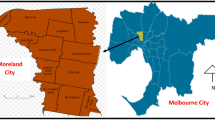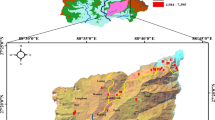Abstract
Flash floods are the most hazardous types of floods, specifically in urban areas, since they impose huge financial damages and tremendous life loss. A flood risk map is required to identify the most vulnerable areas of a city for better management of this phenomenon. This research aims at achieving the risk and vulnerability maps of the city of Sanandaj, Kurdistan Province, Iran, using the geographical information system and fuzzy analytic hierarchy process through the assessment of several conditioning factors. The parameters slope, elevation, profile curvature, drainage density, land use, and distance from waterways were applied to prepare a hazard of flood map of Sanandaj city. Also, effective information layers, including slope, elevation, permeability index, distance from hospitals, distance from fire stations, distance from trails, distance from refueling centers, distance from roads, and distance from historical monuments, were considered for designing a flood vulnerability map. By multiplying the hazard of flood occurrence map and the flood vulnerability map, the flood risk map is obtained. The designed flash flood risk map demonstrated that about 30% of the city’s areas were classified as the most prone to flash floods. The results indicate that the flash flood is a serious concern in the city of Sanandaj, which should be considered by the city’s officials and authorities. The designed flood risk map can be used as an appropriate management tool for reducing or avoiding flood risks.













Similar content being viewed by others
References
Alavi MS, Fallahi A, Mottaki Z, Aslani F (2021) Post-disaster sheltering process after the 2019 floods, in Golestan province, Iran. Int J Disaster Resil Built Environ. https://doi.org/10.1108/IJDRBE-03-2021-0023
Azadtalab M, Shahabi H, Shirzadi A, Chapi K (2020) Flood hazard mapping in Sanandaj using combined models of statistical index and evidential belief function. Motaleate Shahri 9(36):27–40
Azari H, Matkan AA, Shakiba A, Pourali SH (2007) Simulation and flood warning using integration of hydrological models, GIS, and rainfall estimation by remote sensing. Iran J Geol 3(9):39–51
Bahrami J, Gavili A, Chapi K, Rahmati O (2021) Evaluation of flood susceptibility in Telvar river basin using evidence weight models and Bayesian logistic regression. Watershed Manag Res. https://doi.org/10.22092/wmrj.2021.354344.1405
Bathrellos GD, Karymbalis E, Skilodimou HD, Gaki-Papanastassiou K, Baltas EA (2016) Urban flood hazard assessment in the basin of Athens Metropolitan city, Greece. Environ Earth Sci 75(4):319
Bodoque JM, Amérigo M, Díez-Herrero A, García JA, Cortés B, Ballesteros-Cánovas JA, Olcina J (2016) Improvement of resilience of urban areas by integrating social perception in flash-flood risk management. J Hydrol 541:665–676
Chapi K, Singh VP, Shirzadi A, Shahabi H, Bui DT, Pham BT, Khosravi K (2017) A novel hybrid artificial intelligence approach for flood susceptibility assessment. Environ Model Softw 95:229–245
Dandapat K, Panda GK (2017) Flood vulnerability analysis and risk assessment using analytical hierarchy process. Model Earth Syst Environ 3(4):1627–1646
Danumah JH, Odai SN, Saley BM, Szarzynski J, Thiel M, Kwaku A, Kouame FK, Akpa LY (2016) Flood risk assessment and mapping in Abidjan district using multi-criteria analysis (AHP) model and geoinformation techniques,(cote d’ivoire). Geoenviron Disasters 3(1):1–13
Ding H, Liao Y, Lin B (2017) High risk flash flood rainstorm mapping based on regional L-moments approach. In: EGU general assembly conference abstracts. p 19410
Duttagupta S, Mukherjee A, Das K, Dutta A, Bhattacharya A, Bhattacharya J (2020) Groundwater vulnerability to pesticide pollution assessment in the alluvial aquifer of Western Bengal basin, India using overlay and index method. Geochemistry 80(4):125601
Ekmekcioğlu Ö, Koc K, Özger M (2021) District based flood risk assessment in Istanbul using fuzzy analytical hierarchy process. Stoch Environ Res Risk Assess 35(3):617–637
Falguni M, Singh D (2020) Detecting flood prone areas in Harris County: a GIS based analysis. GeoJournal 85(3):647–663
Farajzadeh M, Elahi S (2020) Climatic analysis in western Iran (Case study: Sanandaj synoptic station). Clim Change Res 1(3):52–64
Fusami AA, Aleem KF (2016) Flood vulnerability mapping using geospatial technique for controlling flood along River Yobe Basin in Nigeria. Int J Geomat Geosci 6(4):1748–1750
Garambois PA, Roux H, Larnier K, Castaings W, Dartus D (2013) Characterization of process-oriented hydrologic model behavior with temporal sensitivity analysis for flash floods in Mediterranean catchments. Hydrol Earth Syst Sci 17(6):2305–2322
Gaume E, Livet M, Desbordes M, Villeneuve JP (2004) Hydrological analysis of the river Aude, France, flash flood on 12 and 13 November 1999. J Hydrol 286(1–4):135–154
Gigović L, Pamučar D, Bajić Z, Drobnjak S (2017) Application of GIS-interval rough AHP methodology for flood hazard mapping in urban areas. Water 9(6):360
Heidari M, Sayfouri N, Miresmaeeli SS, Nasiri A (2020) Analysis of the man-made causes of Shiraz flash flood: Iran, 2019. Prehosp Disaster Med 35(5):588–591
Huang J, Fu X, Ke ZB (2007) Application of analytic hierarchy process (AHP) in choosing engineering scheme of urban flood control. J Water Res Archit Eng 5(1):52–55
Hussain M, Tayyab M, Zhang J, Shah AA, Ullah K, Mehmood U, Al-Shaibah B (2021) GIS-based multi-criteria approach for flood vulnerability assessment and mapping in district Shangla: Khyber Pakhtunkhwa, Pakistan. Sustainability 13(6):3126
Ic O, Po I, Du A, Ia N (2017) Flood vulnerability mapping of Lokoja metropolis using geographical information system techniques. J Geosci 5(5):229–242
Kazuva E, Zhang J, Tong Z, Si A, Na L (2018) The DPSIR model for environmental risk assessment of municipal solid waste in Dar es Salaam city, Tanzania. Int J Environ Res Public Health 15(8):1692
Khan AN (2011) Analysis of flood causes and associated socio-economic damages in the Hindukush region. Nat Hazards 59(3):1239
Khosravi K, Pourghasemi HR, Chapi K, Bahri M (2016) Flash flood susceptibility analysis and its mapping using different bivariate models in Iran: a comparison between Shannon’s entropy, statistical index, and weighting factor models. Environ Monit Assess 188(12):1–21
Khosravi K, Melesse AM, Shahabi H, Shirzadi A, Chapi K, Hong H (2019) Flood susceptibility mapping at Ningdu catchment, China using bivariate and data mining techniques. Extreme hydrology and climate variability. Elsevier, Amsterdam, pp 419–434
Koks EE, Jongman B, Husby TG, Botzen WJ (2015) Combining hazard, exposure and social vulnerability to provide lessons for flood risk management. Environ Sci Policy 47:42–52
Lee JH, Jun HD, Park MJ, Jung JH (2011) Flash flood risk assessment using PROMETHEE and Entropy method. J Korean Soc Hazard Mitig 11(3):151–156
Lee S, Lee S, Lee MJ, Jung HS (2018) Spatial assessment of urban flood susceptibility using data mining and geographic information system (GIS) tools. Sustainability 10(3):648
Messner F, Meyer V (2006) Flood damage, vulnerability and risk perception–challenges for flood damage research. Flood risk management: hazards, vulnerability and mitigation measures. Springer, New York, pp 149–167
Ogden FL, Sharif HO, Senarath SUS, Smith JA, Baeck ML, Richardson JR (2000) Hydrologic analysis of the Fort Collins, Colorado, flash flood of 1997. J Hydrol 228(1–2):82–100
Ouma YO, Tateishi R (2014) Urban flood vulnerability and risk mapping using integrated multi-parametric AHP and GIS: methodological overview and case study assessment. Water 6(6):1515–1545
Papaioannou G, Loukas A, Vasiliades L, Aronica GT (2017) Sensitivity analysis of a probabilistic flood inundation mapping framework for ungauged catchments. Eur Water 60:9–16
Rahmati O, Zeinivand H, Besharat M (2016) Flood hazard zoning in Yasooj region, Iran, using GIS and multi-criteria decision analysis. Geomat Nat Haz Risk 7(3):1000–1017
Romanescu G, Hapciuc OE, Minea I, Iosub M (2018) Flood vulnerability assessment in the mountain–plateau transition zone: a case study of Marginea village (Romania). J Flood Risk Manag 11:S502–S513
Rosso R, Rulli MC (2002) An integrated simulation method for flash-flood risk assessment: 2. Effects of changes in land-use under a historical perspective. Hydrol Earth Syst Sci 6(2):285–294
Saaty TL (1980) The Analytic Hierarchy Process: Planning, Priority setting, Resource allocation. 19. Mc Graw-Hill, New York
Sebald C (2010) Towards an integrated flood vulnerability index: a flood vulnerability assessment. Unpublished Master of Science (MSc) Thesis, University of Southampton, UK
Sema HV, Guru B, Veerappan R (2017) Fuzzy gamma operator model for preparing landslide susceptibility zonation mapping in parts of Kohima Town, Nagaland, India. Model Earth Syst Environ 3(2):499–514
Seyghal Y, Naime IB, Irani AA (2019) Criminal policy based on hazards science a case study of the floods of 2019 in Khuzestan and Shiraz. Environ Hazards Manag 6(3):1–2
Shafizadeh-Moghadam H, Valavi R, Shahabi H, Chapi K, Shirzadi A (2018) Novel forecasting approaches using combination of machine learning and statistical models for flood susceptibility mapping. J Environ Manag 217:1–11
Shehata M, Mizunaga H (2018) Flash flood risk assessment for Kyushu Island, Japan. Environ Earth Sci 77(3):1–20
Wisner B, Blaikie P, Cannon T, Davis I (2004) At risk: natural hazards, people’s vulnerability and disasters. Psychol Press. https://doi.org/10.4324/9780203714775
Zeleňáková M, Blistan P, Purcz P (2015) Assessment of flood vulnerability in the Bodva catchment using multi-criteria analysis and geographical information systems. River Basin Manag 8:51–59
Funding
The authors declare that no funds, grants, or other support were received during the preparation of this manuscript.
Author information
Authors and Affiliations
Contributions
All authors contributed to the study conception and design. Material preparation, data collection, and analysis were performed by SA, HA, KC, RSA, and BE. The first draft of the manuscript was written by KC, and all authors commented on previous versions of the manuscript. All authors read and approved the final manuscript.
Corresponding author
Ethics declarations
Conflict of interests
The authors have no relevant financial or nonfinancial interests to disclose.
Additional information
Publisher's Note
Springer Nature remains neutral with regard to jurisdictional claims in published maps and institutional affiliations.
Rights and permissions
Springer Nature or its licensor holds exclusive rights to this article under a publishing agreement with the author(s) or other rightsholder(s); author self-archiving of the accepted manuscript version of this article is solely governed by the terms of such publishing agreement and applicable law.
About this article
Cite this article
Ahmadi, S., Amjadi, H., Chapi, K. et al. Fuzzy flash flood risk and vulnerability assessment for the city of Sanandaj, Kurdistan Province, Iran. Nat Hazards 115, 237–259 (2023). https://doi.org/10.1007/s11069-022-05552-z
Received:
Accepted:
Published:
Issue Date:
DOI: https://doi.org/10.1007/s11069-022-05552-z




